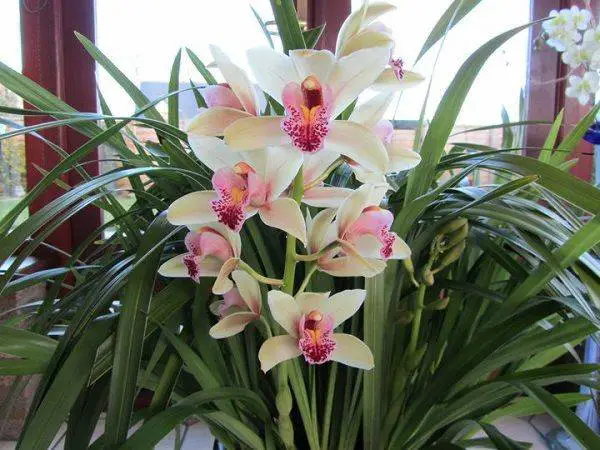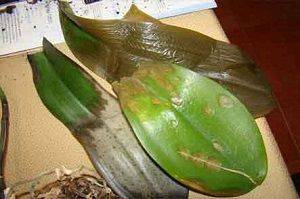Plants, depending on the species, have their own preferences and limits of the conditions in which they normally exist and develop. Orchids are no exception here.
And although tens of thousands of their species and varieties are found on all continents of the Earth, including the northern regions, except for Antarctica, not all of them are cold-resistant or thermophilic.
Keeping a plant in conditions that are not suitable for it can cause depression of its condition and even death. Find out from our article how cold can orchids tolerate and what temperature orchids like.

Microclimate Temprature for orchids at home
Tropical orchids grown in apartments or home greenhouses prefer similar living conditions. However, if you delve more deeply into all the nuances, it turns out that each species has its own preferences and whims.
In general, orchid plants prefer:
- bright diffused lighting;
- temperatures of about 22-26 ° С and their daily fluctuations by 5-6 ° С;
- high relative humidity (about 70% or more);
- stable feeding;
- Fresh air.
All types of orchids prefer similar growing conditions.
Important! The process of photosynthesis is most intense at a temperature of 25 ° C and bright light.
Here you can read Types Of Orchids with groups division.
What Temperature Different Orchids Species Like?
The orchid family has about 30,000 species, and all these plants can be conditional, for completeness of understanding, divided into 3 groups:
- thermophilic species;
- cold-loving species;
- frost-resistant.
Heat-loving Orchids Species
This group includes:
- phalaenopsis ;
- wanda ;
- ludisia ;
- shoes , etc.
Such plants grow in the tropical climatic zone at altitudes up to 500-700 m above sea level. This area is characterized by a consistently high air temperature and relatively small daily and seasonal fluctuations (7-10 ° C). Summer daytime temperatures -27-30 ° C, can reach 40°C, which is accompanied by strong evaporation of moisture.
The temperature for the thermophilic orchids should not fall below 15 ° C . Orchids of a moderate temperature regime can also be attributed to these plants.
Cold-loving Orchids Species
Cold-loving ones include:
- cymbidium ;
- cellogin ;
- odontoglossum ;
- cattleya ;
- shoes , etc.
Cymbidium.
Most of these orchids are found in tropical mountain cloud forests, at altitudes of more than 600-3500 m. Here, characteristic temperature fluctuations are observed, in some areas reaching 20-25 ° C per day.
In summer, the average daytime air temperature is 22-25 ° C, nighttime – 11-14 ° C. In winter 20-21 ° C and 9-10 ° C. However, fluctuations can be higher.
This is the most difficult group to grow indoors, since not everyone has the opportunity to keep these plants in winter at a temperature of 10 ° C, in bright light.
Cold resistant Orchids Species
These are plants of the middle lane that are found up to Siberia:
- orchis ;
- finger-root;
- lyubka;
- some shoes.
Require seasonal changes in climatic conditions. In nature, wintering, they can withstand severe frosts.
Check out guide How to make garlic water for orchids?
how cold can orchids tolerate?
What is good for one part of the world, can be deadly for other part of the world what is good for one can be destructive for others. It is an expression of the principle that, in precarious equilibrium and balance, all nature is held up.
In the context of growing orchids, it can be said that those conditions that are ideal for one species can be detrimental to another. If we take, for example, phalaenopsis, then the limit that it can withstand is +14 ° C, well, let it be +10 ° C, if the plant is in a dried state. At the same time, for Rossioglossum, this is the normal wintering temperature, without which flowering is impossible.
For Rossioglossum, +10 is absolutely normal.
Thus, everything depends on the specific type of plant in question. In the narrow sense of understanding, low temperature, of course, has a depressing effect on the life processes in the plant. Especially if we mean thermophilic orchids that are grown on the windowsills of apartments.
At the same time, it is known that orchids are characterized by high adaptability, which is especially pronounced in hybrids. Therefore, we can say that the low temperature is not so terrible for the same slow and lazy phalaenopsis, as its sharp drop in one direction or the other.
However, it is still better not to risk and experiment by keeping such plants in the cold. Since 90% of what is sold in flower shops is grown and adapted to warm and moderate temperatures – from 20 to 26 ° C
As already described above, orchids can withstand short-term drops in temperature below the permissible level. The least stress and damage can be done if the critical point is reached gradually and for a short time. At the same time, keep the plant dry and do not water it.
Advice! To increase resistance, hormonal agents can be used. Treatments with epin are effective 1-2 days before the expected negative impact.
For the period of winter dormancy, orchids are preferably kept in cool conditions. These plants include only those that survive this period in nature:
- cymbidium ;
- Rossioglossum;
- odontoglossum,
- cellogin, etc.
The optimal winter day temperature for them is in the range of 10-15 ° C with bright lighting for 10-12 hours a day and poor watering.
See also growing orchids in water beads.
Can orchids recover from cold damage?
Hypothermia looks like wet, watery, slimy spots on the plant.
For a heat-loving orchid, 30 minutes at a temperature of 10-15 ° C is enough to get frostbite of tissues. Cold-loving ones withstand more, and the defeat is observed at a temperature of 0 ° C (± 2 ° C).

Resuscitation for such plants is not carried out, but only symptomatic treatment. If 1-2 leaves of an orchid are frozen, then they are cut to a living, healthy tissue, and the places of the cuts are treated with charcoal or cinnamon.
In case of damage to the stem area, the leaf is removed completely, carefully removing it from the plant so as not to damage the stem and roots. Total, severe frostbite that affected the entire orchid is not treated, the plant is disposed of.
Attention! Orchids should not be kept in a cold draft near an open window during winter ventilation.
How do you keep an orchid from getting too cold?
Many people talk a lot about how important daily and seasonal temperature drops are for orchid flowering. However, few people tell how to achieve this in an apartment, especially in winter when the central heating is on.
The temperature difference during home maintenance is achieved naturally.
In city apartments, the amount of drops necessary for planting flower buds is easily achieved in a natural way, while, at the right time. This refers to the period of time in the fall – when it is already cool, but the heating is not working yet, and in the spring when the heating was turned off, but it has not yet warmed up.
It is also easy to regulate the temperature during the heating season using valves and thermostats, including automatic ones, that are installed directly on heating radiators.
Important! Nighttime temperatures should be 5-10 ° C lower than daytime temperatures.
Does an orchid give birth to babies in the cold or warm?
In nature, orchids reproduce by babies or Keiki after flowering in the rainy season, which is accompanied by a relative increase in temperatures and abundant nutrition.
What should be the air temperature during flowering?
The temperature should be within the normal range that exists for a particular species. It should be understood that lowering the temperature by 2-3 ° C slightly reduces the intensity of flowering. That is, the orchid dissolves the buds more slowly and blooms longer. The heat will accordingly shorten the overall flowering time.
Must see Blue Sapphire Orchid.
Conclusion
It turns out that to give a direct answer “yes” or “no” to the question “Is the orchid afraid of cold and frost?” – does not seem possible. It is always necessary to take into account the orchid species characteristics and preferences of each individual plant. Follow these recommendations, be careful and enjoy the orchids.
